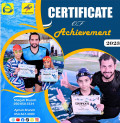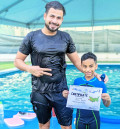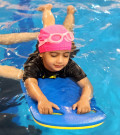
Kids Swimming Learn the Butterfly Stroke with Joy
2023-12-27 - swimmingSwimming is not just a life skill; it's an exhilarating
experience that brings joy and confidence to kids. Among the various swimming
strokes, mastering the butterfly stroke stands out as a challenging yet
rewarding achievement. In this article, we'll explore the exciting journey of
kids learning the butterfly stroke, the basics of the stroke, effective
teaching techniques, common mistakes to avoid, and the numerous benefits beyond
the pool.
I. Introduction
A. Importance of Learning Butterfly Stroke
The butterfly stroke is not just another swimming technique;
it's a powerhouse of physical and mental development. As kids learn this
stroke, they enhance their strength, coordination, and endurance. Moreover, the
butterfly stroke cultivates a sense of discipline and determination.
B. Benefits for Kids
Beyond the physical benefits, learning the butterfly stroke
instills a sense of accomplishment in children. It boosts their self-esteem,
teaching them that with practice and perseverance, they can conquer challenges.
As a full-body workout, it contributes to their overall fitness, setting a
foundation for a healthy lifestyle.
II. Basics of Butterfly Stroke
A. Body Positioning
To execute a perfect butterfly stroke, correct body
positioning is crucial. Kids will learn how to maintain a streamlined body,
reducing resistance in the water. This not only improves their speed but also
prevents unnecessary fatigue.
B. Arm Movement
The distinctive arm movement of the butterfly stroke
requires coordination and strength. Breaking down the stroke into individual
components helps kids grasp the sequence and rhythm, making the learning
process more manageable.
C. Leg Movement
Coordinating leg movement with the arms is essential for an
effective butterfly stroke. Simple yet effective exercises can help kids
understand the role of their legs in propulsion, ensuring a smooth and
efficient swim.
III. Teaching Techniques
A. Breaking down the Stroke
Understanding the butterfly stroke can be overwhelming for
kids. Breaking it down into manageable parts allows them to focus on specific
elements, gradually building up to the complete stroke.
B. Use of Swim Aids
Incorporating swim aids, such as floatation devices and swim
fins, can make learning the butterfly stroke more enjoyable. These aids provide
support and boost confidence, especially for beginners.
C. Fun Exercises for Learning
Learning through play is a proven method for children.
Introducing fun exercises and games not only keeps them engaged but also
reinforces the muscle memory needed for the butterfly stroke.
IV. Common Mistakes to Avoid
A. Overemphasis on Speed
In their eagerness to master the butterfly stroke, kids may
overlook the importance of proper technique. Emphasizing technique over speed
prevents the development of bad habits that can hinder progress.
B. Neglecting Proper Technique
Rushing through the learning process can lead to neglecting
crucial aspects of the stroke. Patience is key; ensuring kids master each
component before moving on contributes to long-term success.
C. Fear and Anxiety
Fear of water is a common obstacle in swimming. Addressing
these fears with empathy and patience is essential. Creating a supportive and
encouraging environment helps kids overcome anxiety and build confidence.
V. Building Confidence
A. Positive Reinforcement
Celebrating small achievements and offering positive
reinforcement boosts a child's confidence. Acknowledging their efforts, no
matter how small, motivates them to persevere in their learning journey.
B. Gradual Progression
Setting realistic goals and allowing for gradual progression
is crucial. Kids need to feel a sense of accomplishment at each stage,
fostering a positive attitude towards learning the butterfly stroke.
C. Encouraging a Supportive Environment
Family and peer support play a vital role in building
confidence. Encouraging words and a supportive environment create a sense of
belonging, making the learning process enjoyable for kids.
VI. Incorporating Fun into Learning
A. Games and Challenges
Making learning enjoyable is key to keeping kids engaged.
Incorporating games and challenges not only adds a fun element to the lessons
but also reinforces the skills needed for the butterfly stroke.
B. Creative Drills
Creativity can turn routine drills into exciting activities.
Designing drills that mimic real-life scenarios or challenges keeps kids
interested and enhances their problem-solving skills.
C. Reward Systems
Implementing a reward system, such as a progress chart or
small incentives, adds an extra layer of motivation. Kids respond positively to
tangible rewards, fostering a sense of achievement and pride.
VII. Swimming Classes for Kids
A. Finding the Right Instructor
Choosing the right swimming instructor is crucial. A
qualified instructor with experience in teaching children ensures that the
learning environment is safe, effective, and enjoyable.
B. Importance of Small Class Sizes
Smaller class sizes allow for more personalized attention,
enabling instructors to address individual needs and progress at the child's
pace.
C. Tailoring Lessons to Individual Needs
Each child is unique, and tailoring swimming lessons to
their individual needs ensures a more effective and enjoyable learning
experience.







.jpg)











































































































































































































